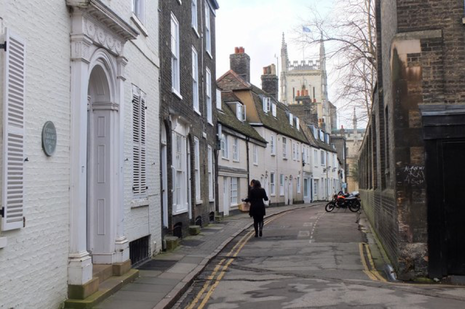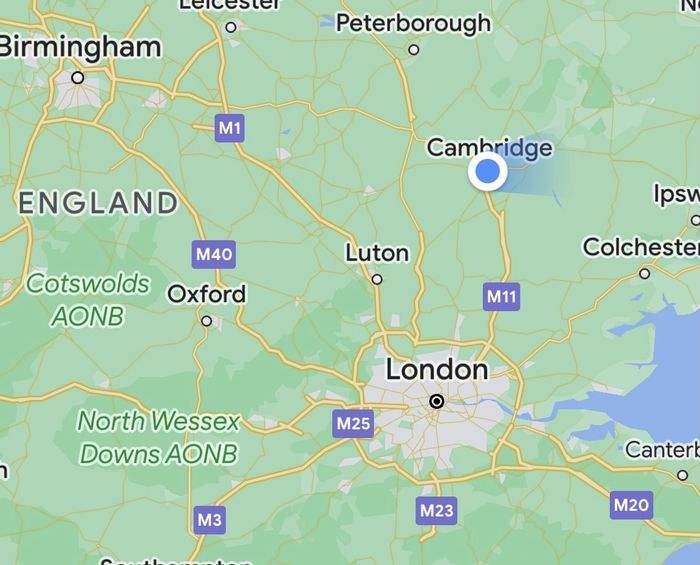A comedy of misidentification
Paddy Davies Jones thought the painting in his attic had led him to Cambridge, until he turned it over to find it featured the Other Place

Above a sofa in the corner of my old sitting room there was an enormous and vaguely incomprehensible piece of modern artwork made up of two large buckets, randomly distributed pages of a manuscript in Cyrillic, and what looked ominously like bloodstains. My sister swears that it’s brilliant. My mother, for her part, has always preferred the small oil painting that hangs on the adjacent wall. Compared to the “buckets of blood”, this modestly sized street scene is hardly noticeable.
I don’t think I’d ever really looked at it until we started the herculean effort of moving houses. I had grown up in that crumbling old house in that middle-of-nowhere, way-out-in-the-sticks, landscape-is-very-stunning-but-please-I’d-love-some-wifi part of the country — but, due to precisely that, we moved to, of all places, residential Clapham. Quite the adjustment.
“It had been there for coming up to two decades, and I had never realised”
Moving houses is always going to be a bit destabilising, moving out of your childhood home especially so, and since I was leaving a stretch of the South Downs so naturally beautiful that every sight could make a half-decent postcard, I couldn’t help but be a bit forlorn.
But moving also proved focusing. Items that had existed mutely in the background since my early childhood were thrown, for the first time, into relief – before being thrown, in most cases, into the skip. There was of course no prospect of binning the painting in question, but it too received a new bout of attention.
I had always assumed it was a print of something from the 19th century, but the double yellow lines on the shadowed street showed otherwise. It had never crossed my mind to question which street in which city it depicted, but this time something about the scene looked familiar. The faded shape of the building in the background, with its distinctive crocketed spires, seemed to resonate with a shape that I had seen many a time gazing out of my top floor window as a first year at Corpus. Then it hit me: the painting that had been hanging above my sofa since as far back as I can remember was of Botolph lane in Cambridge.
“What I had thought to be the gothic revival Pitt building was the 13th century gothic Merton chapel”
The distinctive building in the background was the Pitt building. This lane houses the college accommodation block where I spent countless hours in my first year, and the wonderful Espresso Lane, where I traipse the couple of minutes to daily to secure my coffee fix. It is the hallowed route of merry (sometimes over-merry) Corpus students on the way to Revs, or on the way back from Spoons. It’s where I had my Italian supervisions.
In a way it was comforting – it felt as if a torch was being passed, from the place where I had grown up to the place I’m inhabiting now. It was as if Botolph lane had always been in my life. I showed it off to my Cambridge friends and pointed it out to my sister. She had always assumed it was in Italy, because “the sunlight looked Italian”, but I was sure.
The street seemed so perfect a match. The only detail to disquiet me was the presence of a large lamppost, the focal point of the painting, that I did not remember being on Botolph lane. I reasoned that I might have misremembered.
Oh sweet summer child that I was. Upon flipping over the painting to transport it I was faced with the blunt shock of its caption. It certainly was a lane in an English college town, I was right about that much. “Magpie Lane,” it read, “looking towards Merton College, Oxford”.
What a bitter disappointment. Instead of being warmly presided over all my childhood by an expectant Cambridge, I had been watched by the malignant eyes of The Other Place. “Know thy enemy,” I suppose.
 News / Cambridge students set up encampment calling for Israel divestment6 May 2024
News / Cambridge students set up encampment calling for Israel divestment6 May 2024 News / Cambridge postgrad re-elected as City councillor4 May 2024
News / Cambridge postgrad re-elected as City councillor4 May 2024 News / Proposed changes to Cambridge exam resits remain stricter than most7 May 2024
News / Proposed changes to Cambridge exam resits remain stricter than most7 May 2024 News / Some supervisors’ effective pay rate £3 below living wage, new report finds5 May 2024
News / Some supervisors’ effective pay rate £3 below living wage, new report finds5 May 2024 Fashion / Class and closeted identities: how do fits fit into our cultures?6 May 2024
Fashion / Class and closeted identities: how do fits fit into our cultures?6 May 2024






